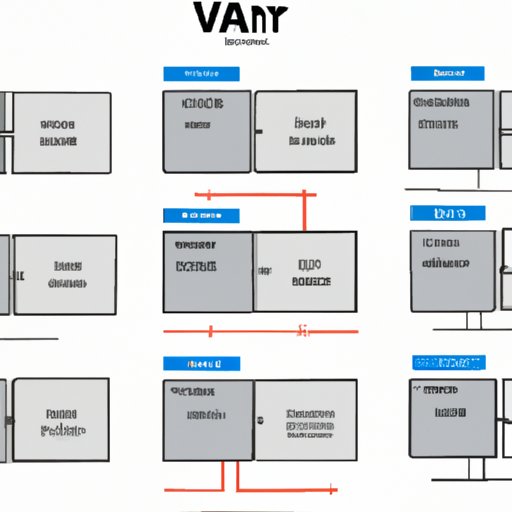Introduction
Value at Risk (VAR) is a risk management tool used by financial market participants to measure and manage the potential for losses due to market movements. It has become increasingly important as global economic uncertainty grows. In this article, we will explore the basics of VAR in financial markets, analyze the benefits and risks of using VAR, outline the different types of VAR models, understand how to calculate VAR, examine the role of VAR in portfolio management, and investigate the impact of VAR on investment decisions.

Explaining the Basics of VAR in Financial Markets
Value at Risk (VAR) is a statistical measure of the potential loss that an investment portfolio may incur over a specified period of time, under normal market conditions. It is calculated by taking into account factors such as volatility, correlations, and other market risks. VAR is used to determine the maximum amount of money that can be lost in a given period, usually one day or one week. The goal is to ensure that the potential losses are within acceptable limits.
VAR is used by financial market participants to assess and manage the risk associated with their investments. By understanding the risk associated with their portfolios, investors can make informed decisions about their investments and take action to reduce the risk of large losses. This helps to protect their capital and maximize returns.
Analyzing the Benefits and Risks of Using VAR
Using VAR provides several advantages for investors, including improved portfolio performance and better risk management. VAR can help investors identify and monitor potential risk exposures, allowing them to make more informed decisions about their investments. Additionally, VAR can be used to set limits on the amount of money that can be invested in a particular asset. This helps to prevent investors from taking on too much risk, which can lead to large losses.
However, there are some risks associated with using VAR. For example, if the assumptions made when calculating VAR are incorrect, then the results could be misleading. Additionally, VAR does not take into account extreme market events, such as black swan events, which could lead to unexpected losses. As such, investors should use VAR in conjunction with other risk management tools to ensure that their portfolios are adequately protected against potential losses.

Outlining the Different Types of VAR Models
There are several different types of VAR models, each of which is used for different purposes. The most common types of VAR models include the historical simulation model, the Monte Carlo simulation model, and the stress testing model.
The historical simulation model uses historical data to estimate the potential losses that an investment portfolio may incur. This model is relatively simple and can provide quick results, but it does not take into account future changes in the market. The Monte Carlo simulation model uses random numbers to simulate future market conditions, allowing for more accurate predictions of potential losses. Finally, the stress testing model uses scenarios to test how an investment portfolio would perform under extreme market conditions.
Understanding How to Calculate VAR
Calculating VAR requires several steps. First, the investor must select the timeframe and confidence level for the calculation. Then, the investor must collect data on the historical prices of the assets in the portfolio and calculate the expected return and standard deviation of the portfolio. Next, the investor must calculate the value at risk by multiplying the standard deviation by a factor based on the chosen confidence level. Finally, the investor must subtract the expected return from the value at risk to arrive at the final VAR figure.
Several factors can influence the calculation of VAR, including the size of the portfolio, the type of assets in the portfolio, the timeframe for the calculation, and the chosen confidence level. Investors should carefully consider these factors when calculating VAR to ensure that they are getting an accurate picture of the potential losses that their portfolios may incur.
Examining the Role of VAR in Portfolio Management
VAR can be used to improve portfolio management by helping investors identify and monitor potential risk exposures. By understanding the risk associated with their portfolios, investors can make more informed decisions about their investments and take steps to reduce the risk of large losses.
However, there are some challenges associated with using VAR for portfolio management. For example, VAR does not take into account changes in market conditions, so it may not be an accurate indicator of potential losses in the future. Additionally, VAR cannot account for all potential risks, so it is important for investors to use other risk management tools in conjunction with VAR.

Investigating the Impact of VAR on Investment Decisions
VAR can have a significant impact on both long-term and short-term investment decisions. On the one hand, VAR can help investors identify potential risks and make more informed decisions about their long-term investments. On the other hand, VAR can help investors identify potential opportunities and make more informed decisions about their short-term investments.
By understanding the risks associated with their investments and taking steps to mitigate those risks, investors can maximize their returns and minimize their losses. Additionally, VAR can help investors identify and capitalize on potential opportunities, allowing them to achieve their financial goals.
Conclusion
In conclusion, Value at Risk (VAR) is an important risk management tool used by financial market participants to measure and manage the potential for losses due to market movements. VAR can help investors identify and monitor potential risk exposures, allowing them to make more informed decisions about their investments. Additionally, VAR can be used to set limits on the amount of money that can be invested in a particular asset, helping to prevent investors from taking on too much risk. Finally, VAR can have a significant impact on both long-term and short-term investment decisions, helping investors maximize their returns and minimize their losses.
This article has explored the basics of VAR in financial markets, analyzed the benefits and risks of using VAR, outlined the different types of VAR models, understood how to calculate VAR, examined the role of VAR in portfolio management, and investigated the impact of VAR on investment decisions. While VAR can be a useful tool for investors, it should be used in conjunction with other risk management tools to ensure that their portfolios are adequately protected against potential losses.
(Note: Is this article not meeting your expectations? Do you have knowledge or insights to share? Unlock new opportunities and expand your reach by joining our authors team. Click Registration to join us and share your expertise with our readers.)
